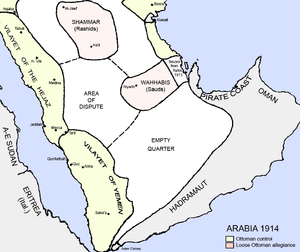Ottoman Arabia

The Ottoman era in the history of Arabia lasted from 1517 to 1918. Ottoman degree of control over these lands varied over the four centuries with the fluctuating strength or weakness of the Empire's central authority.[1][2]
History
Part of a series on the |
|---|
| History of Saudi Arabia |
 |
| Saudi Arabia portal |
Early period
In the 16th century, the Ottomans added the Red Sea and Persian Gulf coast (the Hejaz, Asir and Al-Hasa) to the Empire and claimed suzerainty over the interior. The main reason was to thwart Portuguese attempts to attack the Red Sea (hence the Hejaz) and the Indian Ocean.[3] As early as 1578, the Sharifs of Mecca launched forays into the desert to punish the Najdi tribes who mounted raids on oases and tribes in the Hejaz.[4]
The emergence of what was to become the Saudi royal family, known as the Al Saud, began in Nejd in central Arabia in 1744, when Muhammad bin Saud, founder of the dynasty, joined forces with the religious leader Muhammad ibn Abd al-Wahhab who was from the Hanbali school of thought,[5][6] This alliance formed in the 18th century provided the ideological impetus to Saudi expansion and remains the basis of Saudi Arabian dynastic rule today.[7]
Rise of the Saudi state
The first Saudi state was established in 1744 in the area around Riyadh, rapidly expanded and briefly controlled most of the present-day territory of Saudi Arabia.[8] When Ibn Abd al-Wahab abandoned the position of imam in 1773, the spread of Saudi control over the whole southern and central Najd was completed.[9] In the late 1780s, the northern Najd was added to the Saudi emirate.[9] In 1792, Al-Hasa fell to the Saudis.[9] The Saudi emirate gained control of Taif in 1802, and of Medina in 1804.[9]
The first Saudi state was destroyed by 1818 by the Ottoman viceroy of Egypt, Mohammed Ali Pasha.[10] A much smaller second "Saudi state", located mainly in Nejd, was established in 1824. Throughout the rest of the 19th century, the Al Saud contested control of the interior of what was to become Saudi Arabia with another Arabian ruling family, the Al Rashid. By 1891, the Al Rashid were victorious and the Al Saud were driven into exile in Kuwait.[11]
Dissolution of the Ottoman Empire
At the beginning of the 20th century, the Ottoman Empire continued to control or have a suzerainty (albeit nominal) over most of the peninsula. Subject to this suzerainty, Arabia was ruled by a patchwork of tribal rulers,[12][13] with the Sharif of Mecca having pre-eminence and ruling the Hejaz.[14]
In 1902, Ibn Saud took control of Riyadh in Nejd and brought the Al Saud back to Nejd.[11] Ibn Saud gained the support of the Ikhwan, a tribal army inspired by Wahhabism and led by Sultan ibn Bijad and Faisal Al-Dawish, and which had grown quickly after its foundation in 1912.[15] With the aid of the Ikhwan, Ibn Saud captured Hasa from the Ottomans in 1913.
In 1916, with the encouragement and support of Britain (which was fighting the Ottomans in World War I), the Sharif of Mecca, Hussein bin Ali, led a pan-Arab revolt against the Ottoman Empire to create a united Arab state.[16] Although the Arab Revolt of 1916 to 1918 failed in its objective, the Allied victory in World War I resulted in the end of Ottoman suzerainty and control in Arabia.[17]
Territorial divisions
During the era of Ottoman rule, the territory of modern Saudi Arabia was divided between the following entities:
- Ottoman provinces and emirates:
- Sharifate of Mecca (968–1925; Ottoman control 1517–1803; 1841–1919)
- Egypt Eyalet (1517–1701; 1813–40)
- Jeddah Eyalet (1701–1813; 1840–1872)
- Hejaz Vilayet (1872–1918)
- Lahsa Eyalet (1560–1630)
- Najd Sanjak (1871–1918)
- Yemen Eyalet (1517–1636; 1849–1872)
- Yemen Vilayet (1872–1918)
- Saudi states:
- First Saudi State (1744–1818)
- Second Saudi State (1818–1891)
- Emirate of Nejd and Hasa (1902–1921; became modern Saudi Arabia)
- Other states and entities:
- Emirate of Jabal Shammar (1836–1921)
- Idrisid Emirate of Asir (1906–1934)
References
- ↑ Wayne H. Bowen (2008). The History of Saudi Arabia. Greenwood Publishing Group. p. 68. ISBN 978-0-313-34012-3. Retrieved 2013-06-12.
- ↑ Chatterji, Nikshoy C. (1973). Muddle of the Middle East, Volume 2. p. 168. ISBN 0-391-00304-6.
- ↑ William J. Bernstein (2008). A Splendid Exchange: How Trade Shaped the World. Grove Press. p. 191. ISBN 978-0-8021-4416-4. Retrieved 2013-06-12.
- ↑ James Wynbrandt (2010). A Brief History of Saudi Arabia. Infobase Publishing. p. 101. ISBN 978-0-8160-7876-9. Retrieved 2013-06-12.
- ↑ Bowen, Wayne H. (2007). The history of Saudi Arabia. pp. 69–70. ISBN 978-0-313-34012-3.
- ↑ Harris, Ian; Mews,Stuart; Morris, Paul; Shepherd, John (1992). Contemporary religions: a world guide. p. 369. ISBN 978-0-582-08695-1.
- ↑ Faksh, Mahmud A. (1997). The future of Islam in the Middle East. pp. 89–90. ISBN 978-0-275-95128-3.
- ↑ "Reining in Riyadh" by D. Gold, 6 April 2003, NYpost (JCPA)
- ↑ 9.0 9.1 9.2 9.3 Tim Niblock (2013-01-11). Saudi Arabia: Power, Legitimacy and Survival. Routledge. p. 12. ISBN 978-1-134-41303-4. Retrieved 2013-06-12.
- ↑ "The Saud Family and Wahhabi Islam". Library of Congress Country Studies.
- ↑ 11.0 11.1 "History of Arabia". Encyclopaedia Britannica Online. Retrieved 7 June 2011.
- ↑ Murphy, David (2008). The Arab Revolt 1916–18: Lawrence Sets Arabia Ablaze. pp. 5–8. ISBN 978-1-84603-339-1.
- ↑ Al Rasheed, Madawi (1997). Politics in an Arabian oasis: the Rashidis of Saudi Arabia. p. 81. ISBN 1-86064-193-8.
- ↑ Anderson, Ewan W.; Fisher, William Bayne (2000). The Middle East: geography and geopolitics. p. 106. ISBN 978-0-415-07667-8.
- ↑ Dekmejian, R. Hrair (1994). Islam in revolution: fundamentalism in the Arab world. p. 131. ISBN 978-0-8156-2635-0.
- ↑ Tucker, Spencer; Roberts, Priscilla Mary (205). The Encyclopedia of World War I. p. 565. ISBN 978-1-85109-420-2.
- ↑ Hourani, Albert (2005). A History of the Arab Peoples. pp. 315–319. ISBN 978-0-571-22664-1.
| ||||||||||||||